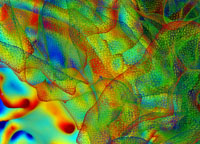Archived Content
The National Institute of Mental Health archives materials that are over 4 years old and no longer being updated. The content on this page is provided for historical reference purposes only and may not reflect current knowledge or information.
Genes and Circuitry, Not Just Clinical Observation, to Guide Classification for Research
• Science Update

Source: http://afni.nimh.nih.gov/afni/suma
NIMH is launching a long-term project aimed at ultimately improving treatment and prevention by studying classification of mental illness, based on genetics and neuroscience in addition to clinical observation. The Research Domain Criteria (RDoC) project is not intended to replace psychiatry's existing diagnostic system for practitioners and will proceed in an independent direction, said Bruce Cuthbert, Ph.D., Director of the NIMH Division of Adult Translational Research, who is directing the effort. By taking a fresh look - without preconceived categories - the project aims to improve the validity of classification for researchers.
RDoC will create a framework to study basic dimensions of functioning — such as fear or memory. It will encompass multiple levels of analysis, from genes to neural circuits to behaviors — cutting across traditional diagnostic categories.
Strategy 1.4 of the Institute's Strategic Plan calls for such "new ways of classifying mental disorders based on dimensions of observable behavior and neurobiological measures." Existing classification schemes define disorders mostly on the basis of presenting symptoms and date back to the early l970s — prior to the neuroscience and genetics advances of the past four decades.
Since then, increasing evidence has emerged of overlap among the traditional diagnostic categories. People often present with more than one diagnosis. Evidence of overlapping genetics and implicated brain circuitry across traditional categories is mounting. As with cancers and infectious illnesses, mental illnesses once lumped together as a single disorder are beginning to be understood as multiple illnesses or subtypes that may stem from different causes and require different treatments.
Categories that are too narrow or too broad can stymie research, explained Cuthbert. Some groups of patients may differ in their clinical presentation but have problems traceable to the same underlying causes, while others may seem to share common symptoms ultimately caused by different illness processes. So, traditional, symptom-based categories make it difficult to relate diagnosis to genes, particular brain circuits, or basic behavioral mechanisms.
To address these concerns, RDoC-supported studies will take a non-conventional approach to selecting study samples. Rather than the usual diagnostic categories, participants will be selected on the basis of common problems in a particular behavior or brain mechanism. For example, a study centered on an impulse control circuit in the front of the brain might span samples of people with substance abuse, ADHD, impulsive aggression and pathological gambling. Similarly, people with all currently-defined anxiety disorders might be included in a study of fear circuit dysfunction. Clinical studies have also traditionally excluded people with overlapping, or "co-morbid," diagnoses. By contrast, RDoC studies will embrace such patients, who are more typical of "real world" settings.
Initially, RDoC will focus on studies of fear and executive functioning/working memory circuitry, which have been most frequently implicated in mental disorders and are "poised for translation from neuroscience to psychopathology," said Cuthbert. Among dimensions to be addressed are cognitive constructs developed as part of the NIMH Treatment of Impaired Cognition in Schizophrenia (CNTRICS) initiative, and others relating to negative and positive emotionality, habit behavior, social processes, and regulatory systems.
The RDoC process will be fully transparent to the research community, launching with a series of conferences beginning this Spring, and updated web postings. Major elements of the initiative are expected to be in place within 2 years, with long-term activities extending 5-10 years.
Both diagnostic manuals for practitioners — the Diagnostic and Statistical Manual of Mental Disorders (DSM) and the psychiatric section of the International Classification of Diseases (ICD) — are currently under revision. However, the RDoC process will not impact those revisions in the short run. It may ultimately suggest revisions to diagnostic categories over the coming decades –– and hopefully lead to new treatments targeted on the basis of genetic factors and patterns of abnormal brain circuit activity, said Cuthbert.
References
Endophenotypes: bridging genomic complexity and disorder heterogeneity . Insel TR, Cuthbert BN. Biol Psychiatry. 2009 Dec 1;66(11):988-9. No abstract available. PMID: 19900610
Cuthbert, BN & Insel, TR. Classification issues in women's mental health: Clinical utility and etiological mechanisms. Archives of Women's Mental Health, 2010. Epub ahead of print. PMID: 20058041
